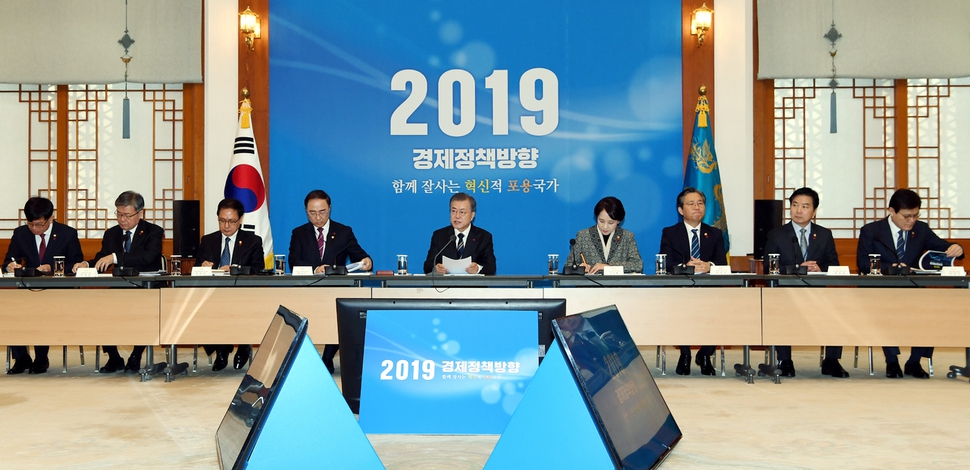 |
|
The construction site of the Barakah nuclear power plant in the United Arab Emirates. (provided by KEPCO)
|
Chief focus shifted to boosting economic vitality
The “income-driven growth” that the Moon Jae-in administration previously presented as its key growth strategy was absent from its economic policy course for 2019. In its place, the administration named priority tasks involving various response measures to boost economic vitality. With the economic policy course announced by the administration at the end of each year representing an important “policy package” providing a glimpse of its direction for governance in the coming year, the change in policy approaches is expected to create some controversy. The 2019 economic policy course announced by the administration on Dec. 17 placed its chief focus on boosting economic vitality. Priority tasks named by the administration included removing obstacles to large-scale corporate investment projects and expanding privately funded efforts. Also emphasized were measures to improving key regulations in areas including home-sharing, vehicle-sharing, and telemedicine. “Promoting economic and social inclusiveness” was listed as a third task after those two – but even there, no reference to “income-driven growth” was to be found. Instead, it included only plans for adjusting the pace of the policy measures emphasized by the administration to date, including a higher minimum wage and 52-hour limit on weekly working hours. The course was a far cry from the governance philosophy stated by the administration in the past. Not long after taking office, the administration declared a shift toward a “person-centered economy” in the economic policy course it announced in July 2017; income-driven growth was positioned as a priority task. The 2018 economic policy course announced in late 2017 included “jobs/income-driven growth” at its very front. Shifting mode due to controversy over minimum wage hike and economic stagnation The very different policy priorities seen in the 2019 economic policy course have inevitably led observers to conclude that the administration is “shifting modes” in response to the political firestorm over the minimum wage hike and the recent signs of an economic downturn. A look at the specifics of the policies shows the shift in focus. To begin with, almost no new policies stand out – about the only ones involved strengthening tax support for the hiring of women returning to the workforce after childbirth and broadening the targets for monthly rent deductions. Most of the others – including increased basic pension and unemployment benefits, child care allowances, and work incentives – have already been included in amended tax laws or next year’s budget. In contrast, a target revision date of Feb. 2019 was given for the minimum wage selection structure and flexible working hour system – both areas where the administration was obliged to slow its approach. In the case of the minimum wage selection structure, the administration plans to finalize its approach in January after going through a process of public debate, including regional discussions and roundtable meetings with young and elderly beneficiaries. The administration’s plan is to finish amending the relevant laws by February so that the terms go into effect when the 2020 minimum wage is set. Changes that are currently being considered include establishing a “minimum wage bracket selection committee” within the Minimum Wage Commission to set brackets targeted for minimum wage hikes, along with a “minimum wage selection committee” to decide the minimum wage within that scope. The administration also plans to push for National Assembly passage in February for an expansion to the current three-month unit periods applied in the flexible working hour system. To this end, it further announced plans to consider increasing the grace period on punishments for violation of the 52-hour weekly working hour limit from the end of 2018 until the date when the increased unit period is finalized. Concerns of moving away from person-centered economy Experts stressed that the shift in focus should not be allowed to undermine the values of the person-centered economy. “The biggest persistent vice in the South Korean economy has been one of structural imbalance – between domestic demand and exports, large corporations and small businesses, and regular and irregular workers,” said Konkuk University economics professor Choi Pae-kun. “Rather than short-term solutions in response to economic conditions, the only way to see improvements is through a package of policies for reworking industry structure, strengthening the social safety net, and promoting a fair economy,” he argued. The Blue House dismissed the concerns. “We are now changing the focus of our economic policy [in contrast with past administrations],” Moon declared in an expanded meeting of Cabinet ministers in economy-related areas the same day. “While there may be some worries and controversy in the process, we need to be patient and wait for it to bear fruit,” he stressed – sending a clear message that the administration is moving forward with the paradigm shift to a person-centered economy. A Blue House senior official said, “There has been no change in the Moon Jae-in administration’s policy vision for an inclusive, innovative country where everyone prospers together through income-driven growth, innovative growth, and a fair economy.” “He was talking about the delay in implementing supplementary measures for small businesses negatively impacted by the minimum wage hike, stressing how the different related measures need to work together so that we achieve what we originally intended,” the official said of Moon’s remarks. By Noh Hyun-woong, Kim Bo-hyeop and Bang Jun-ho, staff reporters Please direct comments or questions to [english@hani.co.kr]






